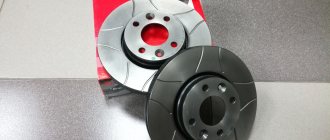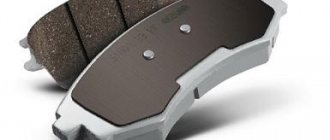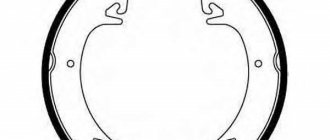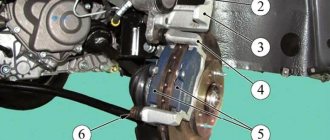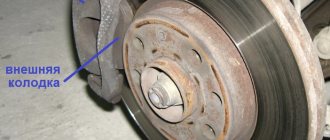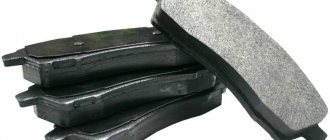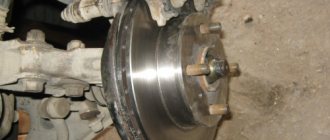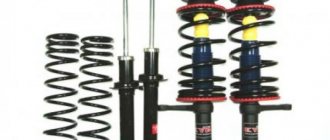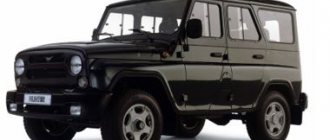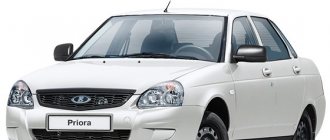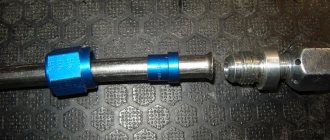Brake pads in a car belong to the category of consumables, the scope of which involves gradual natural wear. This pattern also affects the modern Russian model of the universal class Lada Largus. The service life of the pads is directly influenced by the intensity of use and driving style. On the rear axle, these consumable components are replaced much less frequently than on the front axle, since the operating principle of the entire assembly is based on greater braking force on the front mechanisms.
In order for the replacement of rear brake pads on a Lada Largus car to be successful, you need a clear understanding of the structure of the brake unit, both as a whole and its individual components. Our material is aimed at considering the design features of the brake system parts and the sequence of manipulations that should be resorted to when the need arises to replace the rear pads. We will also provide a number of recommendations to extend the resource intensity of these consumables.
Types of brakes
In the automotive industry there are three main categories of brake mechanisms installed as standard:
- strip structures;
- drum systems;
- disc brakes.
The first “instances” at the dawn of the automobile industry had band brakes. This product covered the entire perimeter of the wheel rim, which allowed the driver to direct the braking force there at a certain moment. He could only pull the tape, which led to the slowdown of the “cart”.
Evolution has done its progressive work, and the outdated “ribbons” were replaced by drums, as in the Lada Largus. The principle of their operation was not intricate, but involved free rotation of the wheel paired with a drum, which, by expanding the pads present in its cavity, received the braking force, causing the car to slow down. This concept worked quite well, but over time some of its shortcomings became apparent. Here the intensity of the drum system has a special influence. The design is closed, and the pads overheat very quickly, which directly affects the deterioration of the braking effect. Along with excessive heating, moisture ingress turned out to be detrimental to the drum mechanism. The presence of water and dirt inside the assembly causes a decrease in performance. It is also not uncommon for a part to break inside a closed drum mechanism. On the one hand, the noise that appears will provide the driver with information about the breakdown that has occurred, and on the other hand, it can provoke damage to the internal working area of the drum itself.
The disc brakes installed in Lada Largus have proven to be the most reliable. In them, all the shortcomings inherent in the previous categories are completely leveled out. The operating principle is as follows. Paired with the wheel, the brake disc itself rotates until it is subjected to the compressive force of the pads. This action is possible by moving the brake rod from the cavity of the hydraulic cylinder present in the caliper. The disc uses a ventilation system that allows you to effectively cool the working area during intensive braking. Note that in the vast majority of cars only the front mechanisms are ventilated. Also, the fact that moisture gets on the disk cannot cause significant damage, since it dries quickly, and the remaining debris is spontaneously removed by centrifugal force. Although there are frequent cases of disc distortion due to frequent alternation of overheating and the passage of water “obstacles” (puddles). The disk mechanism better tolerates loads, so the entire system is as efficient as possible.
Due to the significantly lower cost of drum assemblies compared to disk counterparts, many manufacturers in their budget models resort to a combination of mechanisms, with disks in front and drums in the rear.
Planned replacement of front brake discs and pads and transition to “Summer”.
It's getting warmer... It's time to switch from "Spikes" to "Summer" and carry out a scheduled replacement of the front brake discs and pads. As I wrote earlier in the on-board report, new summer tires Kormoran 195/65R15 91V were purchased this year to replace the already tired KAMA EURO-236 185/65R15 88H. But since the weather was not clear, and the “guy” said that there was no need to change shoes yet... This event was planned “for later,” when it would get warmer and there would definitely be no snow. Moreover, with the transition to “Summer”, from the fall, it was planned to replace the front brake discs and pads. I started replacing the wheels by replacing the rear ones. Nothing interesting here... I loosened the bolts, jacked them up, unscrewed the bolts, threw the rims with the wheels, screwed in the bolts for “casting”, clamped them “by hand”, lowered them from the jack, clamped the wheels with “Dynamo”. Moved to the front. Let me get ahead of myself a little... I bought the pads and discs last year in June, so to speak, done in advance, so that I wouldn’t have to run around, wait, or look for them later. When switching to “Spikes”, the remaining pads were about 5-6 mm. "approximately". The condition of the discs was average. But I decided not to change it for the winter, but to re-roll both the discs and pads. Even when I was doing maintenance at the OD, the master measured the thickness of the disks - 19.9 mm. He warned me about an imminent replacement. But to give credit where it’s due, he didn’t insist on a replacement or didn’t confront the fact that “We changed it” - payment to the cashier! In general, he informed me and recommended an immediate replacement, since the thickness is close to the maximum allowable for these brake discs. And so... I heeded the recommendations. And I purchased: 1. Brake pads ICER 181534700 (Spain). These pads were tested by friends on Nissan Almera and Lada Largus Cross, at my suggestion. Everyone was happy! A friend at LLK, a taxi driver. I rolled out 1 set of pads and ordered another one from me. He said that ICER is better than REMSA. So you can take it for yourself.
Complete with the pads there are new bolts with a retainer applied.
2. Brake discs Nordic Forum NF1699131. The same discs are sold in Largus Shop. In general, everywhere they were positioned as blah blah blah Made in Russia and for Russia... And there was no other information anywhere at the time of their acquisition, but on some forums they were praised, and they posted photos of installed disks on cars, and regularly posted photos of them after the nth mileage. But not a word about the place of production... But in fact:
Made in China. But the office is serious. Not Sun Hun has tea in the basement on his knee. This is what the packaging itself and the brake discs look like.
Each disc is coated with some type of polymer or some kind of paint. A screwdriver does not leave scratches on the coating, a metal brush does the same... I don’t know what they are coated with, but it looks beautiful. Also in the box, each disc is wrapped in a plastic bag. The discs are packed inside the box with cardboard. Let's get started... I remove the front wheel rims, and this picture appears before my eyes:
Stock brake disc. There is wear and tear. It can no longer be used! Replacement!!! But there will be “experts” who will say that the discs are still “fire”, put on the pads and drive on... Fortunately, this is not my option! Brake pads:
Where are they??? Do you see them??? No. Me neither. But they exist! (c) There was no grinding sound. It braked well. But yesterday, when braking, a small squeak appeared. To replace the tool I needed: 1. Open-end wrench set to “13”; 2. Open-end wrench set to “15”; 3. Open-end wrench “18” or ratchet with a small or medium head; 4. Slotted screwdriver (if necessary); 5. Torex “star” T-40; 6. Hammer; 7. Metal brush; 8. Caliper lubricant, high temperature lubricant, thread locker. 9. Device for pressing in brake cylinders. Next there will be photos with comments. There is nothing complicated when replacing brake discs and pads. This topic has been covered more than once. Also, if I may say so, there are detailed instructions for replacing brake pads and discs from Alex123007: “Replacing brake discs and pads on Lada Largus.” I think it makes no sense to describe what was described before me.
The pads are almost rolled to “0”
The edge of the disc has already begun to cut into the pad. That's where the squeak came from yesterday...
Before installing the caliper bracket, I cleaned the guide plates. After assembly, I blew everything out with air, removing any remaining dust and dirt on the working surfaces of the brake system. I did not use brake cleaner (spray). Since the discs are not stained with grease, there is no point in washing the caliper. Because from Ferodo dust, in a day they will become just as black again... ;-( I check everything, tighten it, put on a wheel rim with new tires, tighten it, lower it from the jack, tighten it with Dynamo. That's it... Replacement of the front brake discs and pads is completed, as well as transition from "Winter" to "Summer". The scrap metal was left to a friend whose box I was doing repairs in. He has construction going on and the disks will go into the foundation.
And judging by the state of the metal of the pads... What kind of “chacha” should be watered on the roads to bring the metal to this condition. Living in Germany and traveling around Germany, France, Holland, etc. all year round. The condition of the metal brake pads was much better. The metal was covered with a slight coating of corrosion, but I have never seen such a state of metal there! ps Once I changed my shoes and switched to “Summer”, I changed the interior filter after winter to “charcoal”.
pss After replacing the discs and pads, I skated for about 30 km until the pads got used to it. The discs are covered with a strange coating, because while the pads were getting used to it, there was a squeak, a squeal and such a strong smell that the guard... psss Even after 30 km, even if the mileage is not very long... But the differences between the new Kormoran tires are fundamentally different from the stock KAMA ones. Moreover, for the better. I won’t write a detailed review yet. I would like to test this tire in different conditions. But for now I can say that on dry asphalt, in terms of noise, smoothing out bumps and passing “sleeping” police officers - it’s just class! pssss I'm posting a photo of lapped discs with pads. The pads got used in 30-40 km. During the grinding, I braked in advance, so as not to make an emergency “slipper on the floor”! Right:
Left:
The mirror is smooth. For 200 km. So far no dust from the pads has been found on the discs or mechanisms!
About the operating principle
The brakes in the Lada Largus turned out to be quite balanced and effective. This is confirmed by a lot of tests. For this station wagon, the manufacturer has provided the possibility of equipping it with the following mechanisms:
- front axle – disc units, which are equipped with the function of ventilation and holding a floating bracket;
- rear mechanisms - drum.
The stern brake components are traditional closed designs that are equipped with mechanisms that allow the pads to self-center. Due to this action, the gap is adjusted.
The pads are driven by a hydraulic system, the actuators of which at the front and rear are brake cylinders with retractable pistons. The entire system is dual-circuit, where the order of distribution of braking force occurs according to a diagonal pattern. The complex also has a vacuum booster.
Many cars today are equipped with a useful ABS system. This mechanism prevents the wheels from locking when the brakes are activated, which is especially important in extreme braking modes, when there is a high probability of skidding.
The parking brake is activated via a corresponding lever located in the passenger compartment. The force on the pads is transmitted by a cable located under the bottom in a special line.
The forums are full of questions regarding modifications of the pads installed on the LADA Largus configuration, both with eight and 16-valve engines. Note that the manufacturer installs different brake mechanisms for different versions of the model, which have their own geometric parameters of discs and calipers. The brakes installed on modifications with 16-valve units are more effective.
Signs of pad wear
The instruction manual for a Lada Lagrus with a 16-valve engine, as a rule, contains very detailed information regarding this issue. It also displays all the parameters that characterize the front brake pads. The degree of wear of these consumable components is determined by the residual thickness of the friction linings, which come into direct contact with the discs or drums during braking.
In this regard, gradual and natural abrasion occurs. Many experts are inclined to believe that front brake pads are the most intensively worn consumables. Here you should not wait until the end of the scheduled service life, expressed in mileage (20-30 thousand km), but observe the level of wear with sufficient frequency, and then make a decision on replacement. It is no secret that failed front brake pads provoke increased wear on the working surfaces of discs or drums. Replacing the front brake pads in a Lada Lagrus car is very expensive, so it is not recommended to “bring” the car to this condition.
Renault Sandero Stepway trunk volume
Renault Sandero tank volume
Spoiler for Renault Sandero
Some of the most common signs of wear include the following:
- the appearance of a squeak when the brake is activated;
- spontaneous change in direction of movement from a straight trajectory;
- the brake pedal vibrates when pressed;
- it is impossible to lock the wheels with the handbrake, even with the drive cable fully tensioned;
- reducing the thickness of the disc beyond the limit of 21.8 mm;
- the thickness of the friction linings on the pads has approached the critical value of 2 mm;
- the working surface of the pads is dotted with grooves and chips.
Regular inspection followed by replacement of worn-out components allows you to eliminate the manifestation of these factors.
How to replace rear pads?
Let's move on to consider the sequence of actions when replacing the rear brake pads.
Attention! The pads located on both sides of the car should be replaced. You should also use products from the same manufacturer and identical modification.
- Loosen the tightening torques of the wheel bolts on the rear axle.
- We hang the car (or part of it) using a suitable lifting device.
- The LADA Largus engine, of course, must be turned off and the handbrake deactivated.
- After removing the wheel from one side of the car, we find the brake drum. Let's dismantle it.
- Pads with or without ABS are placed along the edges of the mechanism. The parking brake activation lever directly interacts with one of them. A cylinder is located between the upper edges of the pads. We also observe the presence of springs and a spacer bar, which are necessary to be able to adjust the gap.
- We begin the disassembly steps by dismantling the tension springs, and we remove not only the upper one, but also the lower one. This manipulation can be conveniently performed with pliers. Don't forget about the guide springs.
- We proceed to removing the bar itself along with the mechanism that allows you to “select” the gap.
- It remains to remove the end of the parking brake drive cable.
- Now we remove the pads with or without ABS.
- Before installing new consumables, carefully clean all components of the assembly using a wire brush.
- When installing new pads in LADA Largus, you will need to assemble and install a mechanism that adjusts the gap, as well as return the handbrake cable tip to its position.
- When all the specified elements are installed on the mechanism panel, we tighten the tension springs and return the guide springs to their place.
- We put the drum on carefully, and upon completion we carry out the procedure for adjusting the gap between the already installed pads. To do this, press the pedal three times all the way. After a characteristic click appears, the mechanism switches to the “adjusted” status.
Replacement of the rear brake pads on the Lada Largus has been completed.
Fuel injector
Car won't start, won't start, starter won't turn
Renault Sandero trunk volume
Causes of malfunction
The causes of rear brake pad failure are no different from the front ones. But it’s worth dwelling on them to know them:
- Wear of the friction part. It can only be seen if you take the drum apart. According to the manufacturer's recommendations, the friction part should not be less than 2 mm.
- If brake fluid gets on the linings, it also leads to replacing the pads.
- The friction part is cracked, chipped or chipped. This indicates that the pad needs to be replaced.
Tuning
Many car enthusiasts want to improve the rear brake; to do this, they replace the standard drums with ventilated disc brakes. This operation is done quite simply, but in frequent cases, the hub needs to be replaced.
Installing rear disc brakes
The old rear drums are thrown out and replaced with brake discs, calipers and front pads. This significantly improves the car's braking. These and Sparko offer a full set of rear ventilated brake discs.
As practice shows, disc brakes are 30% more efficient in use, and replacement is carried out in the same way as front brakes. In this case, you do not need to buy separate pads for the rear and front parts. It is enough to buy 4 sets of front pads (each set contains 2 pads).
Recommendations
- Replacement of the rear brake pads in a LADA Largus car should be carried out at least once every two years, because moisture entering the circuit leads to a decrease in the boiling point, and consequently, the efficiency of the system.
- Monitor the fluid level in the reservoir regularly. It has to be replenished.
- If the level decreases rapidly, then take measures to find the source of the leak. The system may have depressurized, and this is very dangerous due to the “loss” of brakes on the road.
- We recommend replacing pads with or without ABS when their wear has reached or begun to exceed the 70 percent limit.
- After winter, do not be lazy to clean the brake calipers and lubricate the guides (in the front mechanisms). This will prevent these nodes from turning sour.
- Don’t skimp on pads, because safety depends on the quality of these consumables.
Replacing rear brake pads is not a difficult, but responsible procedure.
What types of brakes are there?
Throughout the history of the automotive industry, 3 types of brakes have been installed on cars:
- tape;
- drums;
- disk.
The first cars had a band brake system. The wheel axle was covered with tape. The driver had access to it at any time. If he needed to slow down, he pulled the tape, and this allowed him to reduce the speed.
Through “evolution,” the band brake was replaced by a drum mechanism. The principle of operation is the simultaneous rotation of a hollow drum with a wheel, which is bursting inside with pads. This slows down the car. This type of brake has proven itself well, but it also has disadvantages. With frequent heavy use, the drum overheats, since the ventilation in this closed system is not the same as that of a disk mechanism.
Just like overheating, moisture getting into the mechanism is also harmful to the drum. When individual parts become wet, the effectiveness of the brakes decreases. If any part in the drum wears out or falls off, it remains inside the system. This is both a minus and a plus. Indeed, in this case, the driver will hear a knock, and it will be possible to take measures to replace the part.
The disc brake system is the most reliable mechanism that eliminates the above-mentioned disadvantages of previous systems. Disc brakes work by rotating the disc simultaneously with the wheel, and when you press the brake pedal, the pads jam the rotation of the disc from the outside. Unlike the drum, the disc is ventilated, so it is less susceptible to overheating than the drum. The discs do not retain moisture and damaged parts. The operating principle of this system is based on the ability to work under heavy loads. Therefore, you can stop your car faster with disc brakes.
Such mechanisms are often front-facing and ventilated. Ventilation holes cover the entire radius of the disc. Some modifications have transverse ventilation holes. With their help, excess heat is removed, weight is reduced and worn parts are removed.
Due to the fact that the drum mechanism costs much less than the disk mechanism, today both disks and drums are used.
